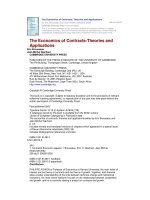0521803861 cambridge university press the observing guide to the messier marathon a handbook and atlas nov 2002
Bạn đang xem bản rút gọn của tài liệu. Xem và tải ngay bản đầy đủ của tài liệu tại đây (7.63 MB, 173 trang )
This page intentionally left blank
The Observing Guide to the Messier Marathon
The Messier Catalogue is a list of 110 galaxies, star clusters and
nebulae, and includes many of the brightest and best-known objects
in the sky. Amateur astronomers can challenge their abilities by
attempting to find all of Messier’s Objects in one night, and thus
complete the Messier Marathon. This book contains over ninety
easy-to-use star maps to guide the observer from one object to the
next, and provides tips for a successful night of observing. The book
also tells the story of the eighteenth century astronomer, Charles
Messier, and how he came to compile his extensive Catalogue. This
complete guide to the Messier Marathon will help the amateur
astronomer to observe the Messier Objects throughout the year,
using a telescope or even a pair of binoculars.
don machholz is an amateur astronomer living in Colfax,
California. He is an active comet hunter, and has discovered nine
comets that now bear his name. He was the Comets Recorder for the
Association of Lunar and Planetary Recorders for twelve years. A
keen writer, Don was the author of a monthly astronomy column for
twenty-two years, and has also written numerous astronomy articles
for local newspapers and radio stations. This is his fourth
astronomy book.
The Observing Guide to
the Messier Marathon
A Handbook and Atlas
Don Machholz
Cambridge, New York, Melbourne, Madrid, Cape Town, Singapore, São Paulo
Cambridge University Press
The Edinburgh Building, Cambridge , United Kingdom
Published in the United States of America by Cambridge University Press, New York
www.cambridge.org
Information on this title: www.cambridge.org/9780521803861
© Don Macholz 2002
This book is in copyright. Subject to statutory exception and to the provision of
relevant collective licensing agreements, no reproduction of any part may take place
without the written permission of Cambridge University Press.
First published in print format 2002
-
isbn-13 978-0-511-06363-3 eBook (NetLibrary)
-
isbn-10 0-511-06363-6 eBook (NetLibrary)
-
isbn-13 978-0-521-80386-1 hardback
-
isbn-10 0-521-80386-1 hardback
Cambridge University Press has no responsibility for the persistence or accuracy of
s for external or third-party internet websites referred to in this book, and does not
guarantee that any content on such websites is, or will remain, accurate or appropriate.
Contents
List of tables
Preface
Acknowledgments
page vii
ix
xii
Part 1 Handbook
1
Charles Messier
Notes to Chapter 1
3
10
2
The Messier Catalogue
Defining the ‘nebulous’ objects
The ‘add-on’ Messier Objects
Putting it all together
Notes to Chapter 2
11
15
21
22
27
3
The Messier Marathon
A short history of the Messier Marathon
Factors a¬ecting the Messier Marathon
Messier Marathons during other times of the year
Getting your astronomy club involved
Hints for running the Marathon
29
31
35
66
72
75
v
Contents
4
Notes to Chapter 3
Messier Marathon logsheet
77
78
Other Marathons
Ideas for di¬erent Messier Marathons
Caldwell Marathon
Lacaille Marathon
Notes to Chapter 4
79
79
83
84
89
Appendix: The Greek alphabet
Glossary
Bibliography and further reading
90
91
93
Part 2 Atlas
Atlas index of Messier Objects
The Messier Marathon Search Sequence Atlas
vi
99
101
Tables
1.1 Comets discovered by and credited to Charles Messier
1.2 Comets independently discovered by Charles Messier
1.3 Comets discovered during each five-year interval,
1758–1802
1.4 Charles Messier timeline
2.1 The Messier Catalogue
3.1 Proposed dates for the Messier Marathon, 2001–2050
3.2 The number of Messier Objects visible from various
latitudes from mid-February to mid-April
3.3 Search sequence for GOTO telescopes
5
6
7
9
23
38
62
65
vii
Preface
Imagine yourself standing next to your telescope at evening twilight.
It is late March. The sky is clear, the wind still. It is the night of the
Messier Marathon. Tonight you will have the opportunity to locate
and observe 110 galaxies, star clusters and nebulae cataloged 200
years ago by a French astronomer named Charles Messier. This
basic list contains some of the best astronomical objects ever seen.
Most amateur astronomers don’t bother finding all of them in a
lifetime; you are going to marathon through the whole list in one
night.
You begin by working your way upward from the western
horizon. After these galaxies you enter the open clusters and
nebulae of the winter Milky Way. The variety of these wonders is
astonishing.
Time passes quickly. You have been marathoning at a leisurely
pace for nearly two hours now. Already you are examining the
galaxies high in the sky near the Big Dipper. Next comes the area you
have feared the most – the Virgo Galaxies. You set out on it using
your trusty star chart. In twenty minutes you have picked up
seventeen more Messier Objects. ‘This is easy,’ you think.
It is now 10:30 pm. You have seen sixty-six of the 110 Messier
Objects. You’re ahead of schedule. You can now sleep, view other
ix
Preface
objects, sketch a planet, photograph the sky, watch for meteors,
locate Pluto, or visit the other marathoners.
It is now 1:30 am. The winter Milky Way has set in the west; the
summer Milky Way has risen in the east. You pick up some of the
most beautiful clusters and nebulae you have ever seen. You swing
through Scorpio, then make another sweep down the Milky Way,
stopping at each Messier Object in your path.
You are enjoying yourself so much that you are a bit startled when
you realize that there is only forty-five minutes until morning
twilight. You have seven more Objects to find. This would normally
not be di~cult, but there is little room for error. You pick up M55,
M75, M15, M2, M72 and M73. Twilight approaches. You set your
scope on the location for M30, your last Messier Object. There is
nothing left to do but stare through your eyepiece. Finally, you see it.
In the span of nine hours you have observed the complete Messier
Catalogue.
As you put away your telescope, your memory plays back images
of everything you have seen. Never before have you observed so
many objects in so little time. Every Messier Object remains fresh in
your mind.
It’s been a good night. You’ve gained a lot of experience and
confidence during the past few hours. You’ll be back again next year.
Let’s re-design the scene. You miss the first two Messier Objects.
Your neighbor burns leaves, engulfing you in thick smoke. Or the
Sheri¬ arrives and tells your group that you must either keep the dirt
road clear of cars, or you’ll all have to leave. Or your spouse calls you
in to put the kids to bed during your second hour. The wind whips
up by 10 pm, blowing over your camera and breaking the filter. The
Virgo Group takes two hours. Your flashlight batteries begin to die.
The fog rolls in one hour before dawn. Do these things happen? Yes.
Every one of them has happened to me while marathoning. These
same things could happen to you, too. But in every situation I’ve
learned something, grown, and became a better observer. And so
will you, no matter how many Messier Objects you see or don’t see.
After a Marathon I see a lot of tired and happy people, some of the
happiest are those who have seen fewer than one hundred Objects –
many of these Objects they have never seen before.
It has been more than two decades since I suggested a ‘Messier
Marathon’ to the San Jose Astronomical Association; I’ve seen it
continue to grow as astronomical clubs and individuals around the
x
Preface
world take part in this challenge to locate and observe all 110 of the
clusters, nebulae and galaxies contained in a catalog compiled by
French comet hunter Charles Messier nearly 200 years ago. This
book is designed to help the observer to find, in one night, as many
Messier Objects as one’s experience, instrument, weather, latitude,
and ability will allow.
xi
Acknowledgments
When Charles Messier compiled his list of 110 galaxies, star clusters
and nebulae over 200 years ago, little did he know that an amateur
astronomer would one day write a book to describe how to find the
whole batch in one night. This book would not be possible without
the e¬orts of others, and I wish to thank them publicly at this time.
Charles Messier wrote his Catalogue. I thank him for including all
the wonderful galaxies, nebulae and clusters (even M30).
I thank those who started the Messier Marathon. This includes
Tom Reiland, Tom Ho¬elder and Ed Flynn. The late Walter Scott
Houston helped bring the idea to a universe-full of amateur
astronomers.
So many others have helped the Messier Marathon to expand and
grow. A.J. Crayon of Arizona has been one of the leaders in
developing the Marathon into a spring ritual in the Arizona Desert.
Many others have also introduced this idea to their local astronomy
clubs.
Two valuable astronomy software programs helped to simplify
my making of the sky maps. The software Deep Space 3D™ was
used for some of the star maps. THE SKY™ software by Software
Bisque was used for others.
When I wanted to illustrate this book I turned to dozens of web
xii
Acknowledgments
sites of beautiful images of the heavens. Deciding which to use was
di~cult because there were so many to choose from. Thanks to all of
you who post these images for us to view.
It was Simon Mitton of Cambridge University Press who urged me
to expand upon my writings and maps and make them accessible to
a world-wide audience. Compiling this manuscript was not easy. I
needed help with my grammar and spelling. Rich Page, a friend,
fellow amateur astronomer and a human spellchecker, looked
through my writings and o¬ered many suggestions. Most of the
mistakes I’ve made while writing this book will never make it to
print because of Rich Page.
A renowned Messier Marathon expert, Hartmut Frommert,
reviewed these pages, making suggestions where needed.
Hartmut’s web site has been most valuable to me as I researched this
book.
Even with all the help in writing this book, I still remain
responsible for the errors. It sounds unfair, but that is just the way
it is.
It has not been easy for my family as I’ve had to share some of their
time with this book. I wish to thank Laura, Matt and Mark for their
patient support during this past year.
Don Machholz
August 2001
Colfax, California
xiii
Part 1
Handbook
1 Charles Messier
Charles Messier lived and worked during a pivotal point in visual
astronomical history. He was one of the first comet hunters,
discovering new comets over a span of four decades, and recording
nearly every observable comet during his career.
His comet hunting resulted in an extensive knowledge of the
night sky, enabling him to organize a catalog of galaxies, clusters
and nebulae. This list of heavenly wonders, known as the Messier
Catalogue, has become one of the most popular lists of its kind. It
includes many of the brightest and best-known objects in the night
sky. Yet the 110 marvels are few enough that even the beginning
amateur astronomer of today can find them all, or nearly all, of them
in one night.
Born on June 26, 1730, in Lorraine, France, Charles was the tenth
of twelve children.1 His father died when he was eleven. Three years
later, in early 1744, the young Charles observed the brilliant multitailed comet of 1744. A month after his eighteenth birthday, in July
1748, he observed an annular solar eclipse from his home town. In
October 1751 he went to Paris in search of a new life. His skill in
penmanship and drafting landed him employment as a record
keeper at a small observatory at the Hotel de Cluny. One of his first
tasks was copying maps of the Great Wall of China and of the City of
3
Part 1 Handbook
Figure 1.1
Charles Messier, 1771. Courtesy of
Dr Owen Gingerich.
what was then called Pekin.2 Other duties included surveying,
making maps of the local area, recording sunspots and compiling
meteorological data. His employer, Joseph Nicholas Delisle, gave
Messier the position of ‘Depot Clerk of the Navy’.
As time went on, Messier was trained to use various telescopes at
the observatory to obtain and record exact positions of heavenly
bodies. His first documented observation was of the planet
Mercury’s transit of the sun on May 6, 1753. By 1757 he was
searching for a comet famously predicted to return by Edmond
Halley. His search was based on Delisle’s calculations of the comet’s
likely position, and was carried out with a 1.5 meter focal length
reflector. The diameter of the telescope’s mirror was about
0.2 meter, but, being made of metal, it reflected little light and gave
poor images.
It was during this period, in 1758, that Messier conceived of his
now famous celestial catalog. While tracking yet another comet of
that year, Messier noted a strong resemblance between this comet
and a nearby nebula. This object, now known as the Crab Nebula,
had been discovered twenty-seven years earlier by John Bevis. It
occurred to Messier that a catalog giving positions and descriptions
of such comet look-alikes would help prevent confusing them with
the real thing.
Meanwhile, Messier continued his quest for Halley’s Comet, not
knowing at the time that Delisle’s calculations were flawed and were
misdirecting his search. On Christmas night, 1758, an amateur
astronomer in Germany, Johann Palitzch, was the first to find
Halley’s Comet. Messier would find it nearly four weeks later, on
January 21, 1759. News of Messier’s find was withheld by Delisle
until April 1, long after the comet faded into the evening sky and reappeared in the morning sky. It is not known why Delisle failed to
publish Messier’s observation in a timely manner, but the practical
result was general skepticism of Messier’s claim to have found the
comet ten weeks earlier. Messier later wrote that the delay in the
announcement was one of the biggest disappointments in his life.
Johann Palitzch found no more comets, but Messier continued
searching until, by 1801, he had discovered or co-discovered twenty
comets. These comet discoveries brought Messier fame and
distinction, along with allowing him the pleasure of viewing the
night sky through a telescope.
Messier used more than a dozen telescopes during his observing
4
1 Charles Messier
Table 1.1. Comets discovered by and credited to Charles Messier.
The comet designation and comet name are followed by the discovery date, with
the month followed by the day and year. The position is in 2000 coordinates and
indicates the position of the comet at discovery. The magnitude is the brightness
of the comet when found. Elongation is the number of degrees the comet was
from the sun as seen from the Earth. Next we see if the comet was found in the
morning or evening sky. The instrument indicated is either a telescope (T) or the
unaided eye (U).
Comet
Comet name
Disc. date
RA
Decl.
El. Mag. Sky Inst.
C/1760 B1
C/1763 S1
C/1764 A1
C/1766 E1
C/1769 P1
D/1770 L1
C/1771 G1
C/1773 T1
C/1780 U2
C/1785 A1
C/1788 W1
C/1793 S2
C/1798 G1
Messier
Messier
Messier
Messier
Messier
Lexell
Messier
Messier
Messier
Messier–Mechain
Messier
Messier
Messier
01/26/1760
09/29/1763
01/04/1764
03/09/1766
08/09/1769
06/15/1770
04/02/1771
10/13/1773
10/27/1780
01/08/1785
11/26/1788
09/28/1793
04/13/1798
10:56
16:28
15:47
1:23
2:27
18:25
2:48
10:27
11:49
2:20
11:19
16:21
3:30
Ϫ15.8
Ϫ6.0
ϩ57.7
ϩ16.2
ϩ13.0
Ϫ16.6
ϩ21.3
ϩ5.5
ϩ12.9
ϩ5.3
ϩ46.3
ϩ13.9
ϩ24.2
133
59
91
34
101
169
31
47
46
103
96
60
31
5.5
5.0
3.0
6.0
5.5
7.0
4.5
4.5
7.0
6.5
6.0
6.0
6.0
M
E
M
E
M
E
E
M
M
E
M
E
E
T
T
U
T
T
T
U
T
T
T
T
T
T
career. To search for Halley’s Comet in 1757–9 he used a reflector
with a mirror of about 0.2 meter diameter. He had access to other
instruments in the observatory, including a refractor with a lens of
about 10 cm, a focal length of 1.1 meter, and a magnification of
120 ϫ. This refractor seemed to be his favorite instrument, and was
used for much of his observing.
Table 1.1 lists the thirteen comets that were discovered first by
Charles Messier.3 One, Comet Lexell, was discovered by Messier, but
carries the name of the orbit calculator, Anders Lexell. This
particular comet had a short orbital period until it passed too close
to Jupiter in 1779. This changed the orbit, and the comet is now lost.
Table 1.2 includes seven additional comets found by Messier
shortly after other discoverers found them.4 Under present
regulations, a comet can carry the names of as many as three
discoverers if their verified independent discovery is made shortly
after the original find. According to these rules it seems unlikely that
any of these comets would also bear Messier’s name. In four cases
5
Part 1 Handbook
Table 1.2. Comets independently discovered by Charles Messier.
The comet designation and comet name are followed by Messier’s discovery date.
The position, magnitude and elongation are for the time Messier found the
comet. ‘Sky’ indicates morning or evening sky, and ‘Late’ denotes the number of
days Messier’s find followed the original discovery.
Comet
Comet name
Disc. date
RA
Decl.
Mag. El.
C/1758 K1
P/1758 Y1
C/1760 A1
D/1766 G1
C/1771 A1
C/1779 A1
C/1801 N1
De la Nux
Halley
Great Comet
Helfenzrieder
Great Comet
Bode
Pons
08/14/1758 5:40 ϩ28.5 7.0
01/21/1759 23:43 ϩ3.0 3.0
01/08/1760 7:57 Ϫ17.6 2.0
04/08/1766 2:50 ϩ26.0 2.5
01/10/1771
8:41 ϩ3.2 5.0
01/19/1779 19:27 ϩ29.8 5.0
07/12/1801
6:45 ϩ72.3 6.5
160
153
140
127
156
151
151
Sky Late
M
E
M
E
M
E
M
80
27
11
17
11
13
11
too much time had elapsed. In two more there were so many nearly
simultaneous discoveries that assigning credit to a single observer
was impossible. In such cases, the comets, appearing quite bright
and spectacular, were called ‘Great Comets’. In the final case there
were several independent discoveries on the same night as
Messier’s, one night after Pons found this, his first, comet.
A look at Charles Messier’s comet discoveries can give us an
insight into his comet-hunting activities. It is interesting to note that
seven of his twenty finds were made during January. This was despite
the fact that in Paris the cloudiest months are December and
January; and January has the greatest number of days of
precipitation (twenty) and the coldest temperatures.5 He seemed to
sweep equally the morning and evening sky, with the morning
comets found at a greater elongation than those found in the
evening sky. Whether this was caused by his sweeping (or sleeping!)
habits, or from horizon height di¬erences, we do not know. He was
also not afraid to sweep through the Milky Way, where many stars
and nebulae tend to mask new comets; nor did he shy away from
areas containing galaxies. From his latitude of ϩ48.8 degrees, he
searched from the North Pole to roughly Ϫ20 degree declination.
In Table 1.3 we take a look at the significance that Messier played
in the field of comet hunting during his lifetime. Most of his comets
were found in his first fifteen years of searching, while nearly half of
the objects listed in his Catalogue were recorded sometime later,
between 1778 and 1781 (Table 1.4).
6
1 Charles Messier
Table 1.3 Comets discovered during each five-year interval, 1758–1802.
The total number of comets discovered is given for each five-year period. The
number discovered by Messier also includes his independent finds. The number
found by others includes the seven comets which Messier found independently
that do not bear his name, plus the one bearing his name along with Mechain’s
(1785 A1).
Years
# Found
# By Messier
# By others
Other discoverers
1758–1762
1763–1767
1768–1772
1773–1777
1778–1782
1783–1787
1788–1792
1793–1797
1798–1802
45
44
45
42
45
47
46
46
46
24
24
24
21
22
21
21
21
22
34
31
31
31
34
37
35
35
35
Klinkenberg
Helfenzrieder
Montaigne
Montaigne
Bode, Mechain
Mechain, C. Herschel
C. Herschel
C. Herschel
Mechain, Pons
Total
46
20
33
Charles Messier received many awards during his lifetime. In
January 1763 he barely missed being elected to the French Academie
Royale des Sciences. On December 6, 1764, he became a foreign
member of the Royal Society of London. He was also elected
member of the Russian Academy of Sciences. In 1769 he earned
membership in the Berlin Academy of Sciences. In 1771, he was
finally elected to the Paris Academy of Sciences. By then he was also
Astronomer of the Navy, Director of the Observatory at Cluny, and a
member of the Royal Academy of Sciences. From 1785 to 1790 he
held the post of editor of the French journal Connaissance des Temps. In
1806 he received the Order of the Cross from Napoleon. These
honors were all in recognition of his careful comet hunting, comet
observing, and his cataloging of nebulae.
On November 26, 1770, Charles Messier married MarieFrancoise de Vermauchampt. They had met shortly after Messier
arrived in Paris. On March 15, 1772, she gave birth to a son (AntoineCharles), who died at the age of eleven days. Messier’s wife died
three days earlier, on March 23, 1772.
On November 6, 1781, Messier su¬ered an 8 meter fall into an ice
cellar. This occurred during the daytime, not at night as some have
reported. Severe injuries resulted, and Messier was sidelined for
7
Part 1 Handbook
Figure 1.2
Comet Hale-Bopp, imaged on March 19,
1997, by Don Machholz.
nearly a year. His first return to the observatory was to observe the
transit of the sun by the planet Mercury on November 9, 1782.
Perhaps this transit brought back memories of his first o~cial
observation, the transit of Mercury twenty-nine years earlier.
During the last decade of the eighteenth century, France was in
political turmoil. Science became less important, and those who
were politically on the wrong side of the establishment su¬ered.
Messier did less and less observing.
In later years Messier lived by himself, then with his sister and his
brother. After they passed away, he lived with a widowed niece, and
in 1815 he su¬ered a stroke. Two years later he contacted dropsy, and
after an illness of only a few days, he died on the night of April 11/12,
1817, at the age of eighty-seven.
8
1 Charles Messier
Table 1.4 Charles Messier timeline.
For each year, we see the comets discovered by Messier and the Messier Objects he
observed. Then we discover the other activities going on in Messier’s life and in
the lives of those around him.
Year Comets found
1756
1757
1758 1758 K1
1759 Halley’s
1760 1760 A1, 1760 B1
1761
1762
1763 1763 S1
1764 1764 A1
1765
Obj. found
Other activities
M32
M1
Begins search for Halley’s Comet
Palitzch finds Halley’s Comet
M2
Delisle retires
Observes transit of Venus
Lacallie dies
Almost elected to Academy of Science
M3–M40
M41
1766 1766 E1, 1766 G1
1767
1768
1769 1769 P1
M42–M45
1770 1770 L1
1771 1770 A1, 1771 G1 M46–M49,
M62
1772
M50
1773 1773 T1
M110
1774
M51, M52
1775
1776
1777
1778
1779 1779 A1
1780 1780 U2
1781
1782
1783
1784
1785 1785 A1
1786
1787
1788 1788 W1
9
M53
M54, M55
M56–M63
M64–M79
Made Member of Royal Society of London
Ocean trip, away from Paris May–Aug.
First Catalogue written
Married; elected to Academy of Science
First Catalogue published, M1–45
Wife and son die
Introduced to Pierre Mechain
Messier sees ‘specks’ crossing sun
Second Catalogue published, M1–68
M80–M106, Final Catalogue published; injured in fall;
M108–M109 Uranus discovery
M107
Observes transit of Mercury
Herschel begins listing objects
Herschel’s first catalog published









